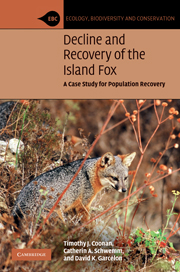Book contents
- Frontmatter
- Contents
- Foreword
- Acknowledgments
- 1 Introduction
- 2 Evolution and genetics
- 3 Social structure, reproduction, mortality and survivorship, and population dynamics
- 4 Food habits, habitat use, activity patterns, and dispersal
- 5 Golden eagles and the decline on the northern islands
- 6 Ecosystem recovery
- 7 Disease and decline on Santa Catalina Island
- 8 Recovery actions
- 9 Recovery actions
- 10 Reproductive biology, by Cheryl Asa
- 11 Diseases of island foxes, by Linda Munson
- 12 Zoos, education, and public participation
- 13 Managing recovery
- 14 The ecological role of island foxes
- 15 Conclusion
- References
- Index
11 - Diseases of island foxes, by Linda Munson
Published online by Cambridge University Press: 05 October 2010
- Frontmatter
- Contents
- Foreword
- Acknowledgments
- 1 Introduction
- 2 Evolution and genetics
- 3 Social structure, reproduction, mortality and survivorship, and population dynamics
- 4 Food habits, habitat use, activity patterns, and dispersal
- 5 Golden eagles and the decline on the northern islands
- 6 Ecosystem recovery
- 7 Disease and decline on Santa Catalina Island
- 8 Recovery actions
- 9 Recovery actions
- 10 Reproductive biology, by Cheryl Asa
- 11 Diseases of island foxes, by Linda Munson
- 12 Zoos, education, and public participation
- 13 Managing recovery
- 14 The ecological role of island foxes
- 15 Conclusion
- References
- Index
Summary
Diseases occur in all wildlife populations to some degree, but usually go unnoticed unless an epidemic occurs or a species approaches extinction. When a species becomes endangered, the major factors contributing to morbidity and mortality need to be identified, the disease risks assessed, and appropriate interventions implemented to prevent extinction and ultimately to ensure recovery. When island fox populations declined precipitously on San Miguel, Santa Rosa, Santa Cruz, and Santa Catalina Islands in the late 1990s, disease was considered among the possible causes (Chapters 5 and 7). Similar population declines had occurred on San Nicolas Island in the 1970s and 1980s but the cause was not identified (Laughrin 1977, Kovach and Dow 1985). Few carcasses were retrieved during the catastrophic declines of the 1990s, and little historic information was available on the incidence of disease in island foxes; as a result it was difficult to determine if disease had played a role in these declines.
The near extinction of four subspecies and need for information to guide recovery efforts prompted the initiation of a comprehensive disease surveillance program in 1998 (Coonan and Rutz 2001; see Chapter 5). The goal of the program was to determine the principal causes of death as well as the prevalence of underlying diseases that might impact foxes through reduced fertility and/or survival. For this survey, a comprehensive necropsy was conducted on all deceased island foxes to characterize their diseases and parasites, as well as to determine causes of death.
- Type
- Chapter
- Information
- Decline and Recovery of the Island FoxA Case Study for Population Recovery, pp. 129 - 143Publisher: Cambridge University PressPrint publication year: 2010



